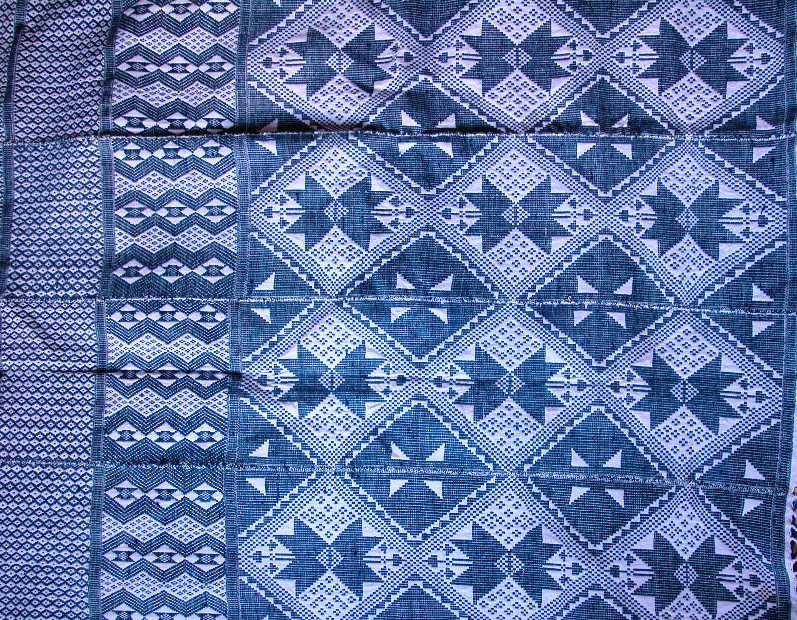PANO DE TERRA
The Pano textiles made in Cape Verde from locally grown cotton used to be hugely popular throughout Upper Guinea. They were even exported at times to Brazil and other parts of Africa. Panos were also worn by most Cape Verdean women well into the late 1800’s. Not only in Santiago but all the other islands as well.
The Pano industry of Cape Verde became dominant after Cape Verde stopped being a regional trading center and transit station for reexporting slaves in the 1600’s. It already started in the 1500’s though. There are many fascinating aspects. The Panos are assumed to have patterns of originally Moorish or Hispano/Morisco design. But this industry was based on Upper Guinean production methods (the loom and the way of combining several strips to make 1 piece of textile).
These production methods are assumed to have been spread by the Mandinga and Wolof specifically. At the time of Portuguese arrival in the 1400’s they were also the only peoples together with the Sereer and Fula being described as wearing cotton clothing. Later on this habit spread gradually, mainly among the elites of southern areas within Upper Guinea.
However the cultivation of cotton and also the actual weaving of the Pano textiles was apparently done exclusively in Senegambia and Mali. Only exception being the Casamance and São Domingos river in Guiné Bissau. Where the Cassanga and Banhun are said to have been early adapters. Followed some time later by the Papel who also got influenced by Cape Verdean settlers in Cacheu. This area would also be the chief buyer of Cape Verdean cotton which they used for making Pano textiles themselves. Aside from also importing lots of Cape Verdean Panos. Cape Verdean Panos were also especially popular in Sierra Leone and Guiné Conakry where the English found them to be indispensable for slave trading.
There were several types of Cape Verdean Pano’s, each carrying its own name. Two Pano types from the 1700’s can be related to Senegal according to Cape Verdean historian Antonio Carreira who devoted an entire study to Panos (Panaria Caboverdeana-Guineense: aspectos históricos e sócio-económicos, 1983).
- Pano Xereos = Sereer
- Pano Gallum = reference to Senegal
Because the production of Panos required specialized labour, Cape Verdean slaveowners sought out experienced weavers. Especially (but not exclusively) Mandinga, Banhun, Sereer and Wolof ones. So actually this might even have influenced the ethnic composition of slave imports into Cape Verde. Not intended for transit to the Americas therefore. This quote is from Cape Verdean trader/writer Lemos Coelho (1684).
____________________
skilled in spinning yarn, hence those of them who come to be enslaved
are very much prized.” ____________________
A final interesting thing to mention is that originally most Panos were produced on the Cape Verdean island of Fogo. Because they had the most cotton cultivation. So perhaps the ethnic composition of slaves living on this island got most influenced. However there was also always significant production in Santiago. And later on in the late 1700’s it also spread to other islands. According to Antonio Carreira the weaving looms of Santo Antão were similar to the ones from Fogo and different from the ones of Santiago. So this might hint at which island was principal in diffusing this technique to other islands.
Recommended Reading Online
– Money, Cloth-Currency, Monopoly, and Slave Trade in the Rivers of Guiné and the Cape Verde Islands 1755–1777 (link to paper)
– Panos da Escravidão: Panos de terra (link to paper)
– The Cape Verdean pano – a unique handicraft (link to website)
– Transformation of “old” slavery into Atlantic slavery: Cape Verde Islands, c. 1500-1879 (link to dissertation)
***
***

***
Picture taken around 1905, first woman on the left wearing Pano de terra.
***
![Rare view of a Cape Verde panos in use, worn at a batuque dance. Detail of a vintage postcard, circa 1905, authocapvert[2] (1)](https://www.cvraiz.com/wp-content/uploads/Rare-view-of-a-Cape-Verde-panos-in-use-worn-at-a-batuque-dance.-Detail-of-a-vintage-postcard-circa-1905-authocapvert2-1.jpg)


